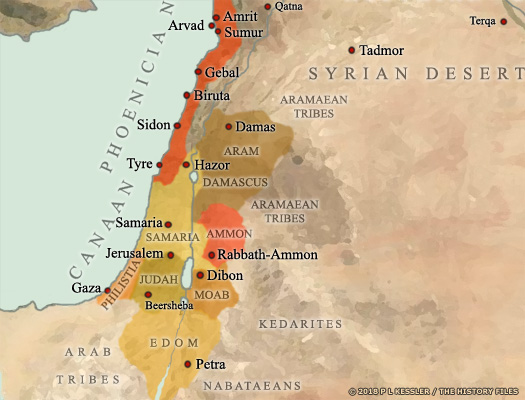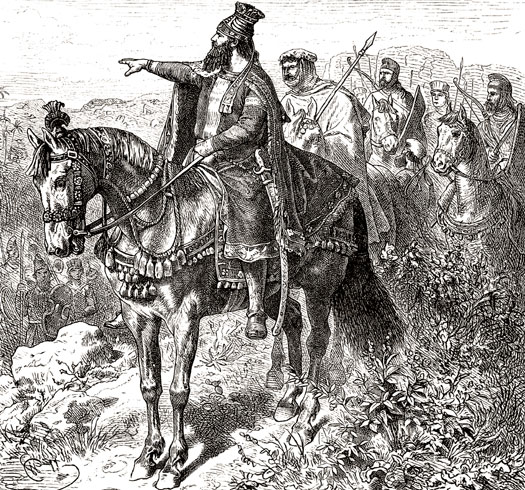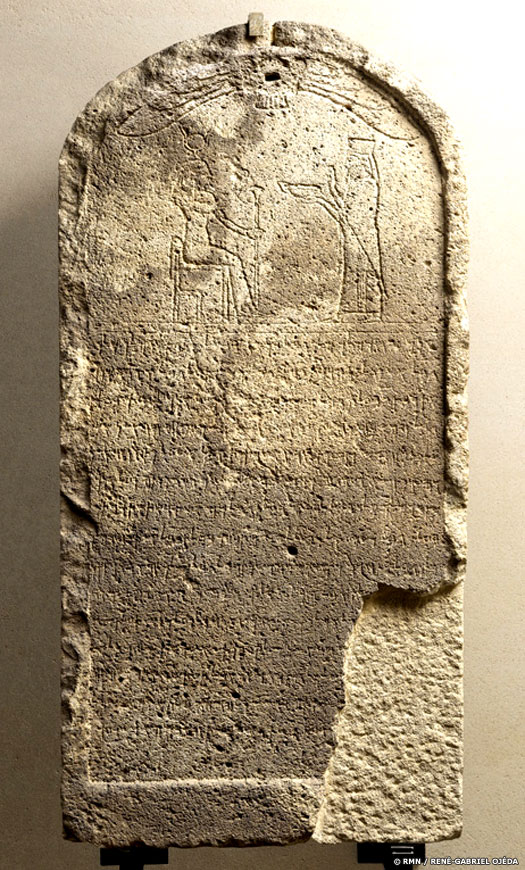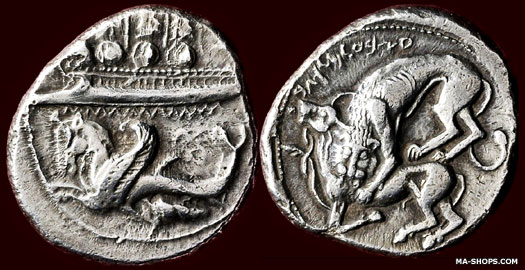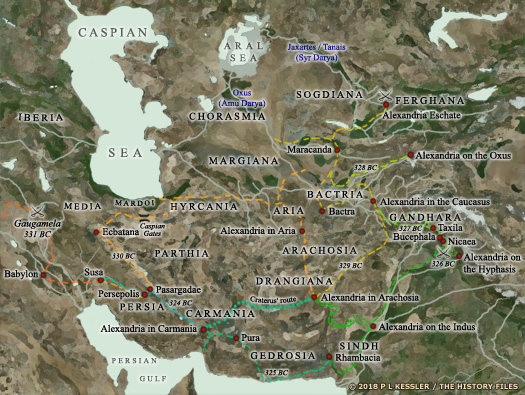
| GEBAL / GUBLA (BYBLOS) Founded as a settlement at some point around 5000 BC, the area was originally home to a small Neolithic fishing community. It is located in modern Lebanon (now the prosperous city of Jubayl, on the Mediterranean coast - the name is the modern form of Gebal), about 42km (26 miles) north of Beirut. The first signs of a town appeared in the third millennium BC, and by the beginning of the Early Bronze Age in 3000 BC it was a prosperous Canaanite city with one of the most important timber trading centres on the coast, and close ties with fourth dynasty Egypt. It quickly developed from there to become one of the main importers of luxury goods, and a key exporter of papyrus to Greece. Originally known as Gubla, and then Gebal, the later name Byblos comes from the Greeks, from those imports of papyrus (or bublos).
c.2000 - 1800 BC :
Egypt maintains a trading presence in the region following links which date back a further millennium. Byblos is overrun and burnt by Amorites during the period of disturbance which follows the collapse of Sumer, but they quickly settle in, rebuild the city, and resurrect trade. Little information is available on the earliest kings, save their names.
fl c.1800s BC :
Abichemou I
fl c.1790s BC :
Yapachemou Abi I
fl c.1700s BC :
Rib-Hadda
Yakin
fl c.1500s BC :
Yantin-Ammu / Yattin / Yantin
Abichemou II
Yapachemou Abi II
Eglia
1453 BC :
The Egyptians conquer the Levant and Syria and establish three provinces in their conquered territories which are named Amurru (in southern Syria), Upe (in the northern Levant), and Canaan (in the southern Levant). Each one is governed by an Egyptian official. Native dynasts are allowed to continue their rule over the small states, but have to provide annual tribute.
fl c.1340s BC :
Rib-Adda / Rib-Addi : 'Mayor of Gebal'. Vassal of Egypt. Exiled and killed.
c.1340 BC :
Relations with neighbouring Amurru are soured by constant complaints from Rib-Adda to his overlords in Egypt that Aziru, the king of Amurru, is trying to overthrow him and force others to join the pro-Hittite camp in local politics. The Egyptian pharaoh only gains a temporary respite when Aziru dies, as Rib-Adda quickly renews his feud with Aziru's sons in Amurru. He also complains vociferously about Yapa-Hadda of Biruta, accusing him of always plotting or committing crimes.
c.1320 BC :
Rib-Adda reports to his Egyptian overlords that his kinsman, the king of Tyre, and his family have been murdered in a coup d'etat. As Rib-Adda had been keeping his own sister and daughters safe there from Amurru's raids, they are presumably also amongst the dead. To make matters worse, Rib-Adda is temporarily forced to flee his city and seek protection with Ammunira of Beyryt in the face of raids by the Hittites, as well as devastating attacks by the habiru.
c.1320? BC :
Ilirabi / Ili-Rapih : Brother. 'Mayor of Gebal'. Vassal of Egypt. Exiled Rib-Adda.
c.1320? BC :
Azirou / Aziru : King of Amurru.
c.1200 BC :
There is general collapse in the region as instability grips the Mediterranean coast and the Hittite empire is destroyed by the Sea Peoples and other various surrounding groups. Arvad, Gebal, Sidon, and Tyre, all with prominent harbours, manage to survive unscathed, although the wealthy customers disappear for a time.
Phoenician Byblos / Gebal :
Descended from the Canaanites who formerly inhabited the entire Levant region, these later Canaanites occupied the long coastal strip that forms modern Lebanon. According to their tradition the city was founded by the god El, and even they considered it to be a city of great antiquity. By at least 1200 BC, the scribes of Byblos were responsible for developing an alphabetic phonetic script which was the precursor of the modern alphabet in the west. By 800 BC it had travelled to Greece, and through the later Greek empire it found acceptance throughout the civilised world. During the first millennium BC, Byblos continued to benefit from trade in spite of Assyrian and Babylonian encroachments, until it was submerged within the Persian empire in 539 BC.
fl 1100s BC :
Zakar Baal
c.1050 BC :
A weakened Egypt loses its remaining imperial possessions in Canaan. Whether Zakar Baal rules before this point or is the first to assume power in the city after the Egyptian withdrawal is unknown. His successor, Ahiram, is eventually laid to rest in a sarcophagus which carries the (to date) oldest-known inscription in the Phoenician alphabet.
fl 1000s BC :
Ahiram
fl c.1000 BC :
Zakar Baal (II?)
10th cent BC :
Byblos loses its position as pre-eminent city to Tyre when that city gains control over the state.
fl c.980 BC :
Ithobaal
fl c.940 BC :
Yahimilik
fl c.930 BC :
Abi-Baal
fl c.920 BC :
Elibaal
fl c.900 BC :
Sibiti Baal / Sibittibaal / Shipitbaal I
10th cent - 701 BC :
Tyre gains control over Byblos and Sidon.
853 BC :
Troops from Byblos are members of an alliance of states which also includes Ammon, Arvad, Damas, Edom, Egypt, Hamath, Kedar, and Samaria. Together they fight Shalmaneser III of Assyria at the Battle of Qarqar which consists of the largest known number of combatants in a single battle to date, and is the first historical mention of the Arabs from the southern deserts. Despite claims to the contrary, the Assyrians are defeated, since they do not press on to their nearest target, Hamath, and do not resume their attacks on Hamath and Damas for about six years.
When the Neo-Assyrian empire threatened the various city states of southern Syria and Canaan around 853 BC, they united to protect their joint territory - successfully it seems, at least for a time fl c.750 - 738 BC :
Sibiti Baal / Sibittibaal / Shipitbaal II : Vassal of Tyre.
738 BC :
Byblos becomes tributary to Tiglath-Pileser III of Assyria.
fl c.710 BC :
Urumilki / Urumiku : Vassal of Tyre.
704 - 701 BC :
With the death of Sargon II of Assyria, many of the former subject states rebel. It takes the Assyrians until 701 BC to get around to quelling the Phoenician states. In Byblos, subject kings are allowed to remain in power, at least during the later stages of Assyrian rule.
fl c.670 BC :
Milkyasap / Milkiashapa / Milkiasaph : Vassal of Assyria.
fl c.650 BC :
Yehawmelek : Vassal of Assyria.
c.612? - 539 BC :
With the fall of Assyria, Tyre appears to restore its control of Byblos.
539 BC :
Byblos and all of Phoenicia is submerged within the Persian empire, which appoints local governors.
Persian Vassal Kings of Byblos / Gebal :
Under Persian control, Phoenicia formed part of a large satrapy which was commanded from Babirush (Babylon). This was the senior great satrapy in the region. The main satrapy of Athura (former Assyria) also fell within Babylonia's administrative umbrella and was subservient to it. It was Strabo who reported (accurately) that Athura consisted of (old) Assyria along with Khilakku, Ebir-nāri, and Phoenicia. Therefore the Persian Satrap Megabyzus and other holders of his office were also satraps of all of these, even if they had their own, lesser satraps.
By at least 1200 BC, the scribes of Byblos (or Gebal, today's city of Jubayl) had been responsible for developing an alphabetic phonetic script which was the precursor of the modern alphabet in the west.
During the first millennium BC, Byblos continued to benefit from trade in spite of Assyrian and Babylonian encroachments, until it was submerged within the Persian empire in 539 BC. Byblos became the fourth of four Phoenician vassal 'kingdoms' to be established (the others being Arvad, Sidon, and Tyre), ostensibly controlled by native sub-kings in the name of the Persian king.
The remains of a fortress outside the Early Bronze Age city walls from this period show that Byblos was a strategic part of the Persian defence system in the eastern Mediterranean. The city itself was somewhat isolated in comparison with Sidon and Tyre, and seems to have developed some distinctive cultural elements of its own as a result. As examples, its fleet does not seem to have participated in the Battle of Salamis in 480 BC, unlike the fleets of the other Phoenician cities, and it did not export its coins abroad. A major difficulty in establishing a chronology for the the kings of Byblos is that none of their inscriptions (whether monumental or monetary) are dated by their years of reign. One of the last-known kings before the Achaemenid period was Milkyasap, who is mentioned in the Annals of Esarhaddon. The first known king after 539 BC was Shipitbaal III, but the chronology for Byblos for this period is extremely vague.
(Information by Peter Kessler, with additional information from Alexander the Great, Krzysztof Nawotka (Cambridge Scholars Publishing, 2009), from The Persian Empire, J M Cook (1983), from The Histories, Herodotus (Penguin, 1996), from The Cambridge Ancient History, John Boardman, N G L Hammond, D M Lewis, & M Ostwald (Eds), from The Social History of Achaemenid Phoenicia: Being a Phoenician, Negotiating Empires, Vadim S Jigoulov (Routledge, 2016), from The History and Archaeology of Phoenicia, Hélène Sader (SBL Press, 2019), and from External Links: Encyclopædia Britannica, and Encyclopaedia Iranica, and An Updated Chronology of the Reigns of Phoenician Kings during the Persian Period (539-333 BC), Josette Elayi (Trans 32, 2007, available in English at DigitOrient).)
539 BC :
All of Phoenicia is submerged within the Persian empire. Many Phoenicians emigrate to the colonies, especially Carthage, which quickly rises to become a major power. The many other colonies in the western Mediterranean also become more important. On Sardinia, for instance, Phoenicians mount a defence against a native Sardi uprising that secures them control of much of the island.
Cyrus the Great freed the Indo-Iranian Parsua people from Median domination to establish a nation that is recognisable to this day, and often, to the west, his empire retained local rulers and dynasties like that of Byblos c.500 BC :
Rulers of Byblos only become known to the historical record with vague certainty from around the middle of the fifth century BC. The oldest Persian-period inscriptions from Byblos date to around 500 BC. Both funerary inscriptions, while they may refer to two important figures (one a king), those references may be to the same person. Sibiti Baal cannot presently be confirmed as a king, although his son certainly is, as the inscription features some uncharacteristic presentation elements, some of which are also on two other inscriptions that are thought dubious (see Elayi's Updated Chronology (p16) for details).
c.500 BC :
Sibiti Baal / Sibittibaal / Shipitbaal III : Persian vassal. Ruled? Died c.500 BC.
c.500 BC :
? : Unnamed king (possibly Sibiti Baal). The Yehawmilk inscription from Byblos is the longest and most significant to be found by archaeologists. Created perhaps around 450 BC (or up to forty years earlier) for the king of that name, it also mentions his father and grandfather, the latter of whom (Urimilk) is also labelled as king. The stele upon which the inscription is made now resides in the Musée de Louvre in Paris.
The Yehawmilk stele was discovered by Ernest Renan during his second examination of the site in 1869 - and then by chance - with the missing lower right-hand corner being discovered a further sixty years later
fl c.475 BC :
Urimilk (II) : Relationship unknown. Vassal king of Byblos.
c.470s BC :
The fact that Urimilk's son, the bearer of the undeciphered name of YHRB'L (which may mean Yeharbaal), does not appear to have a royal title suggests that the kingship jumps a generation. Possible reasons are many, such as his predeceasing his father or Persian dissatisfaction at the possibility of his acceding, but no details are known.
fl 470s? BC :
YHRB'L (Yeharbaal?) : Son. Full name undeciphered. Ruled?
fl c.450 BC :
Yehawmilk / Yehaumilk / Jahavmelik : Son. King of Byblos.
c.450 BC :
Byblos begins minting its own coins shortly before 450 BC, slightly ahead of its major rivals in the form of Sidon and Tyre. Yehawmilk is likely to be about the first king to be responsible for this. The inscriptions can be hard to read and interpret, though. The proposal of a King Germilk is based on a mistaken interpretation.
c.450 - 420 BC :
While Sidon and Tyre - both participants at the Battle of Salamis in 480 BC - have 'dark' periods in their available records until around 450 BC, a similar period for which records are unavailable occurs in Byblos between about 450 BC and 420 BC when the other two cities are recovering. At present there is no information available regarding this apparent mismatch.
fl c.420 - 400 BC :
Elpaal / Elipaol : Known from numismatic evidence.
Paltibaal : Priest, not king.
fl 400 BC : Although Paltibaal (male) and his 'successor', Batnoam (female), are both placed in rough lists of the rulers of Byblos, he is in fact a priest of 'The Mistress of Byblos' (the city's main goddess, possibly to be equated with the Persian-influenced Astarte of Sidon). She is his wife, and both are parents to Ozbaal, the next confirmed king of Byblos. The suggestion is of a new house being founded, or at least of a cadet branch of the existing royal family succeeding to the throne - not, though, as part of the mid-fourth century BC Sidon-led revolt against Persian rule.
Two sides of shekel issued during the reign in Byblos (or Gebal) of Azbaal which means that his parents can also be approximately dated to the early years of the fourth century BC
fl 400 BC :
Bantam / Batnoam : Female. Not named as ruler.
fl c.390s - 350 BC :
Ozbaal / Azbaal (Zakur) : Son. Known from coins with his name.
fl 340s? BC :
Urimilk (III) / Addirmilk : Known from coins.
346 BC :
In tandem with Satrap Mazaeus of Khilakku, Bēlsunu of Ebir-nāri leads fresh contingents of Greek mercenaries to put down the revolt in the Levant. Phoenicia is attacked first (principally involving Sidon), but both satraps are repulsed. The Persian king himself is forced to follow up with a more direct intervention.
fl later 300s BC :
Malcander : A Greek form of a Phoenician name - possibly not even a king.
c.340s? - 332 BC :
Aynel / Enylus : Last Persian vassal king of Byblos.
333 - 332 BC :
In 334 BC Alexander of Macedon launches his campaign into the Persian empire by crossing the Dardanelles. Much of Anatolia falls by 333 BC and Alexander proceeds into Syria during 333-332 BC to receive the submission of Ebir-nāri, which also gains him Harran, Judah, and Phoenicia (principally Byblos and Sidon, with Tyre holding out until it can be taken by force). Athura, Gaza, and Egypt also capitulate (not without a struggle in Gaza's case). Byblos becomes part of the new Greek empire and is quickly Hellenised.
Argead Byblos :
The Argead were the ruling family and founders of Macedonia who reached their greatest extent under Alexander the Great and his two successors before the kingdom broke up into several Hellenic sections. Following Alexander's conquest of central and eastern Persia in 331-328 BC, the Greek empire ruled the region until Alexander's death in 323 BC and the subsequent regency period which ended in 310 BC. Alexander's successors held no real power, being mere figureheads for the generals who really held control of Alexander's empire. Following that latter period and during the course of several wars, Syria and Phoenicia were left in the hands of the Seleucid empire from 301 BC.
The scribes of Byblos (or Gebal, today's city of Jubayl) had been responsible for developing an alphabetic phonetic script which was the precursor of the modern alphabet in the west. The city was one of the great trading centres of the first millennium BC, even despite Assyrian and Babylonian encroachments. Being submerged within the Persian empire in 539 BC meant that it became the fourth of four Phoenician vassal 'kingdoms' to be established, with oversight being provided by a regional satrap in Ebir-nāri (Syria).
Once captured by Alexander the Great, Byblos was not formed into a semi-independent governorship of its own as had been the case under the Persians. Instead the region was united under a single governorship which was based in Tyre. Even this quickly proved to be too small a region for any senior level of governance. In 329 BC Byblos, Sidon, and Tyre were incorporated into the satrapy of Syria, and the Phoenician cities would not regain any meaningful level of independence.
(Information by Peter Kessler, with additional information from Alexander the Great, Krzysztof Nawotka (Cambridge Scholars Publishing, 2009), from The Persian Empire, J M Cook (1983), from The Histories, Herodotus (Penguin, 1996), from The Cambridge Ancient History, John Boardman, N G L Hammond, D M Lewis, & M Ostwald (Eds), and from External Links: Encyclopædia Britannica, and Encyclopaedia Iranica.)
332 - 323 BC :
Alexander III the Great : King of Macedonia. Conquered Persia.
323 - 317 BC :
Philip III Arrhidaeus : Feeble-minded half-brother of Alexander the Great.
317 - 310 BC :
Alexander IV of Macedonia : Infant son of Alexander the Great and Roxana.
332 - 329? BC :
Abdalonymus : Satrap of Byblos, Sidon, & Tyre under the Greek empire.
329? - c.89 BC : The cities of Arados, Byblos, Sidon, and Tyre are incorporated into the satrapy of Syria within the Greek empire. Following the death of Alexander the Great in 323 BC, the latter three are largely dominated by Ptolemaic Egypt until 219-217 BC, when the Fourth Syrian War sees Seleucid ruler Antiochus III fighting Ptolemy IV for control of their mutual border.
The route of Alexander's ongoing campaigns are shown in this map, with them leading him from Europe to Egypt, into Persia, and across the vastness of eastern Iran as far as the Pamir mountain range
Antiochus recaptures Seleucia Pieria, Tyre, and other important Phoenician cities and their Mediterranean ports, but is fought to a draw at Raphia on Syria's southernmost edge. The subsequent peace treaty sees all the gains other than Seleucia Pieria relinquished. Seleucid control is probably reconfirmed more permanently in 195 BC and remains in place until the mid-first century BC when a briefly powerful Armenia muscles its way in.
89 - 69 BC :
Arsacid ruler, Mithradates the Great, launches an attack against the Seleucid empire with Aziz the Arab as his ally. The target is Antiochus X who is killed during the fighting. The weakened and distracted Seleucids also lose Harran to Armenia as Tigranes the Great conquers much of Syria between this point and 69 BC (which seemingly includes the city of Byblos).
? - 68 BC :
Cinyrus : Greek ruler, little known. Vassal to Tigranes?
68 BC :
The imperialistic ambitions of Armenian King Tigranes lead to war with Rome, and a defeated Armenia becomes tributary to the republic following the campaigns of generals Lucullus (69 BC) and Pompey (67 BC). Former Seleucid Syria is lost and, in the following year (68 BC), so is Byblos. Rome now controls much of the region. Events for Byblos now follow the general sequence of events for Phoenicia.
Source :
https://www.historyfiles.co.uk/ |
